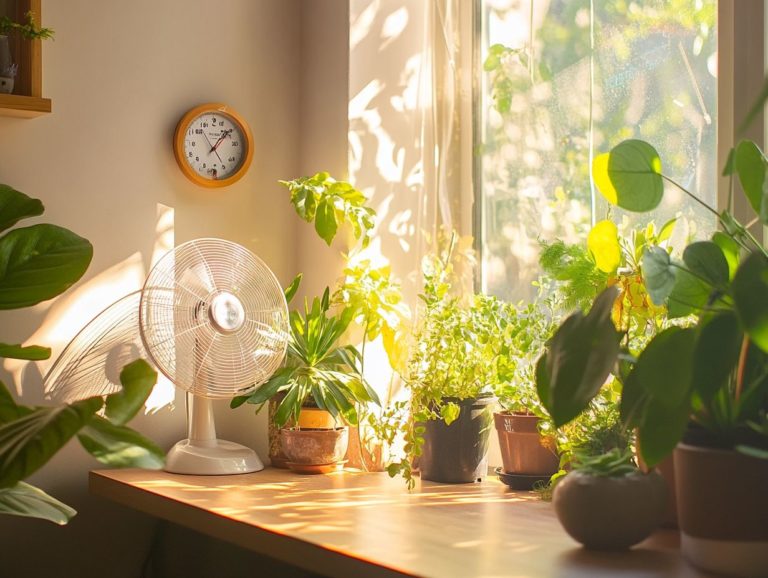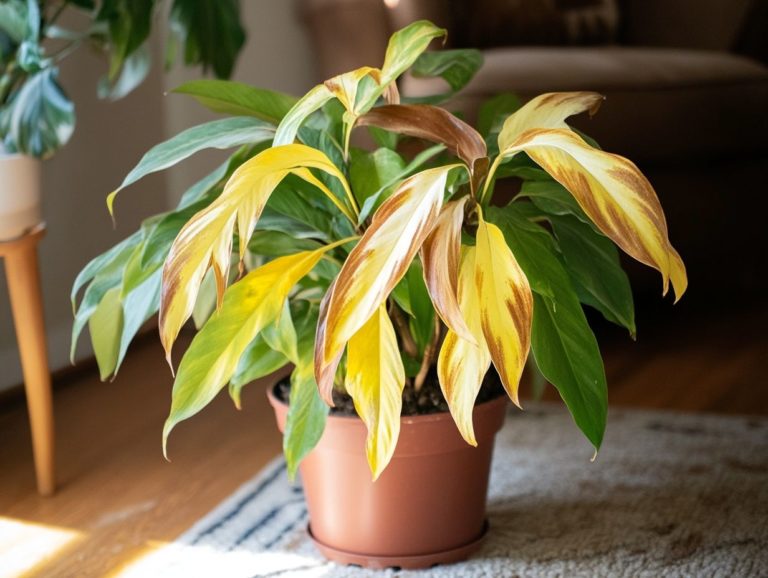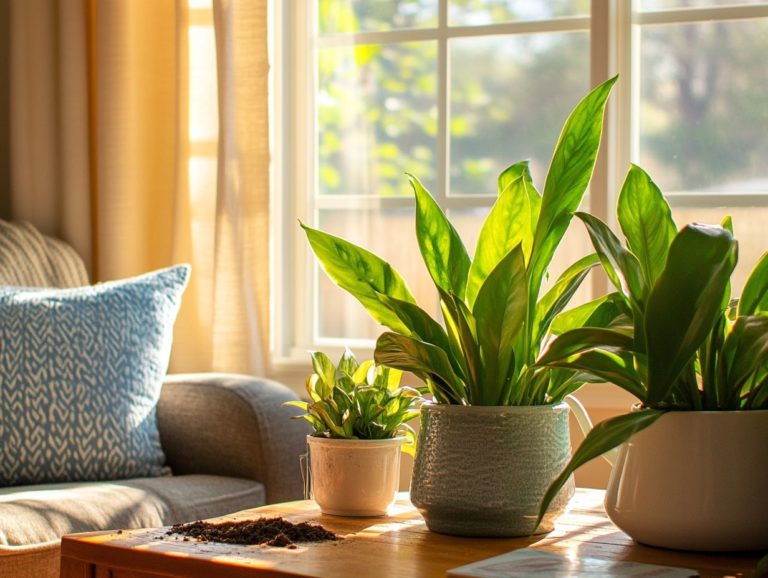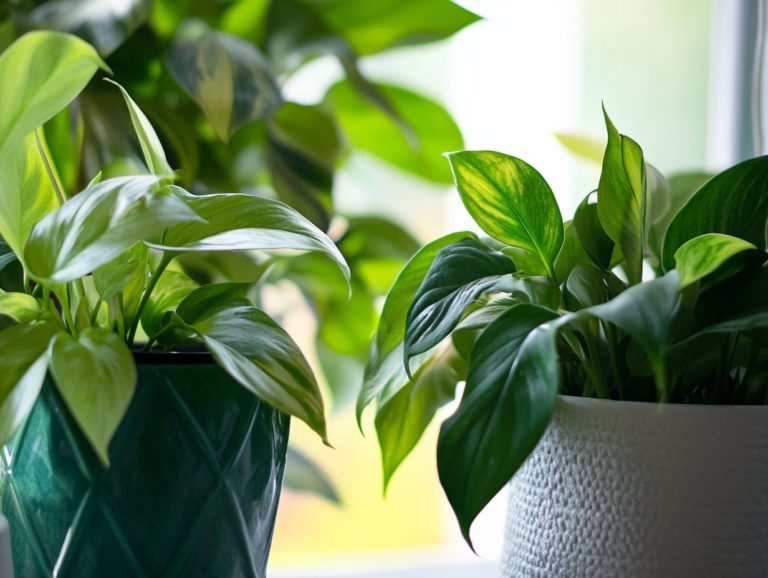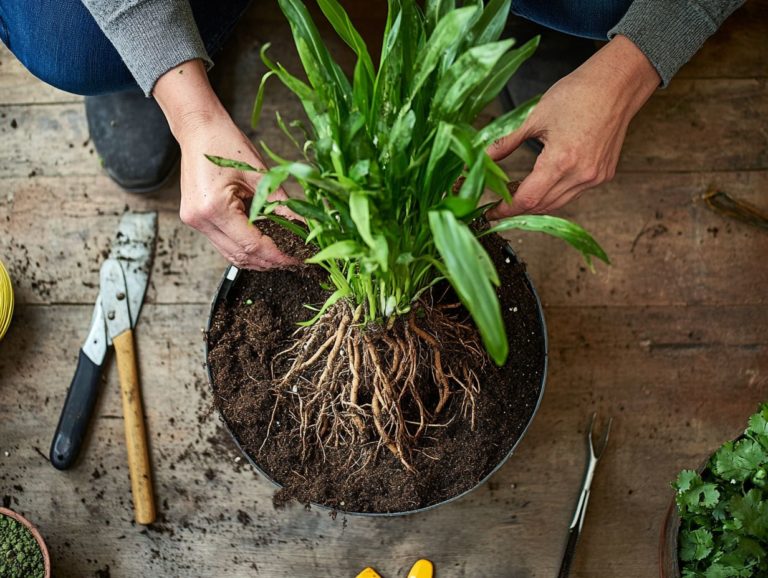Top 7 Tips for Indoor Plant Care Troubleshooting
Indoor plants, such as houseplants, add life and vibrancy to any space.
However, keeping them healthy requires more than just occasional watering.
This article provides essential tips to help you understand your plant’s needs.
We cover everything from watering techniques to selecting the best pot and soil.
You will learn about sunlight needs, humidity control, and pest management.
Identifying and treating common pests, like tiny flying bugs, will be discussed.
Whether you re a new plant parent or have a thriving indoor garden, this guide is for you.
Get ready to elevate your indoor garden to new heights!
Contents
- Key Takeaways:
- 1. Understanding Your Indoor Plant’s Needs
- 2. Proper Watering Techniques
- 3. Choosing the Right Pot and Soil
- 4. Providing Adequate Sunlight
- 5. Managing Humidity Levels
- 6. Identifying and Treating Pests and Diseases
- 7. Pruning and Maintenance
- How Often Should You Water Indoor Plants?
- What Are the Most Common Mistakes in Indoor Plant Care?
- What Are Some Signs of Overwatering and Underwatering?
- How Can You Improve Air Circulation for Your Indoor Plants?
- What Are the Best Fertilizers for Indoor Plants?
- How Can You Create a Suitable Environment for Your Indoor Plants?
- What Are Some Common Indoor Plant Pests and How Can You Get Rid of Them?
- What Are the Benefits of Having Indoor Plants?
- Frequently Asked Questions
Key Takeaways:
- Understand your indoor plants needs for better care and growth.
- Use proper watering techniques to keep your plants healthy.
- Choose the right pot and soil for your indoor plants’ health.
1. Understanding Your Indoor Plant’s Needs
Understanding the needs of your indoor plants is essential for their health and longevity. Light, humidity, and temperature all play a big part in how well your plants do. Each type of houseplant has its unique set of requirements, so tailoring your care to meet these needs is crucial.
For example, while succulents relish bright, direct sunlight, tropical plants often prefer filtered light and higher humidity levels. Watering needs can also differ greatly; some plants like to dry out a bit between waterings, while others thrive in consistently moist soil.
To keep your plants thriving, regularly check for distress signals like dropping leaves, pests, or weak growth. Tackling these issues promptly can make a world of difference. With the right care, your plants will not only survive but truly flourish in their indoor environment.
2. Proper Watering Techniques
Proper watering techniques are crucial for keeping your indoor plants vibrant and healthy. Overwatering can lead to root rot, while underwatering results in discolored leaves and stunted growth definitely not the look you re going for.
One effective method to ensure your plants receive just the right amount of moisture is to use a moisture meter. This handy tool eliminates the guesswork and provides a clear picture of the soil s moisture levels. With it, you can easily assess whether the soil is too dry or overly moist before deciding to water.
Identifying watering issues becomes a breeze. If a plant frequently droops despite regular watering, it might be a sign of poor drainage rather than a lack of moisture. Addressing watering issues is crucial. Take into account the specific plant type, environmental factors such as temperature and humidity, and the soil’s drainage capability. Tailoring your watering frequency based on these elements will help each plant thrive beautifully.
3. Choosing the Right Pot and Soil
Choosing the right pot and potting soil is essential for the growth and nutrition of your indoor plants, ensuring proper soil drainage and helping to prevent common issues like root rot and weak growth while enhancing overall plant health.
When selecting a pot, consider factors such as size, material, and drainage holes. A pot that’s too small can restrict root development, while one that’s overly large might retain too much moisture, creating a breeding ground for problems. Typically, materials like clay or ceramic promote better airflow to the roots, while plastic pots are lighter and do a great job of holding moisture. Don’t underestimate the importance of drainage holes they’re crucial for preventing excess water from accumulating at the bottom, which could lead to rot.
Repotting your plants periodically is an excellent practice, as it introduces fresh soil that replenishes nutrients and encourages healthy growth. Different types of potting mixes cater to specific indoor plants; for example, succulents thrive in gritty, well-draining mixes, while tropical plants flourish in rich, moisture-retaining soils.
4. Providing Adequate Sunlight
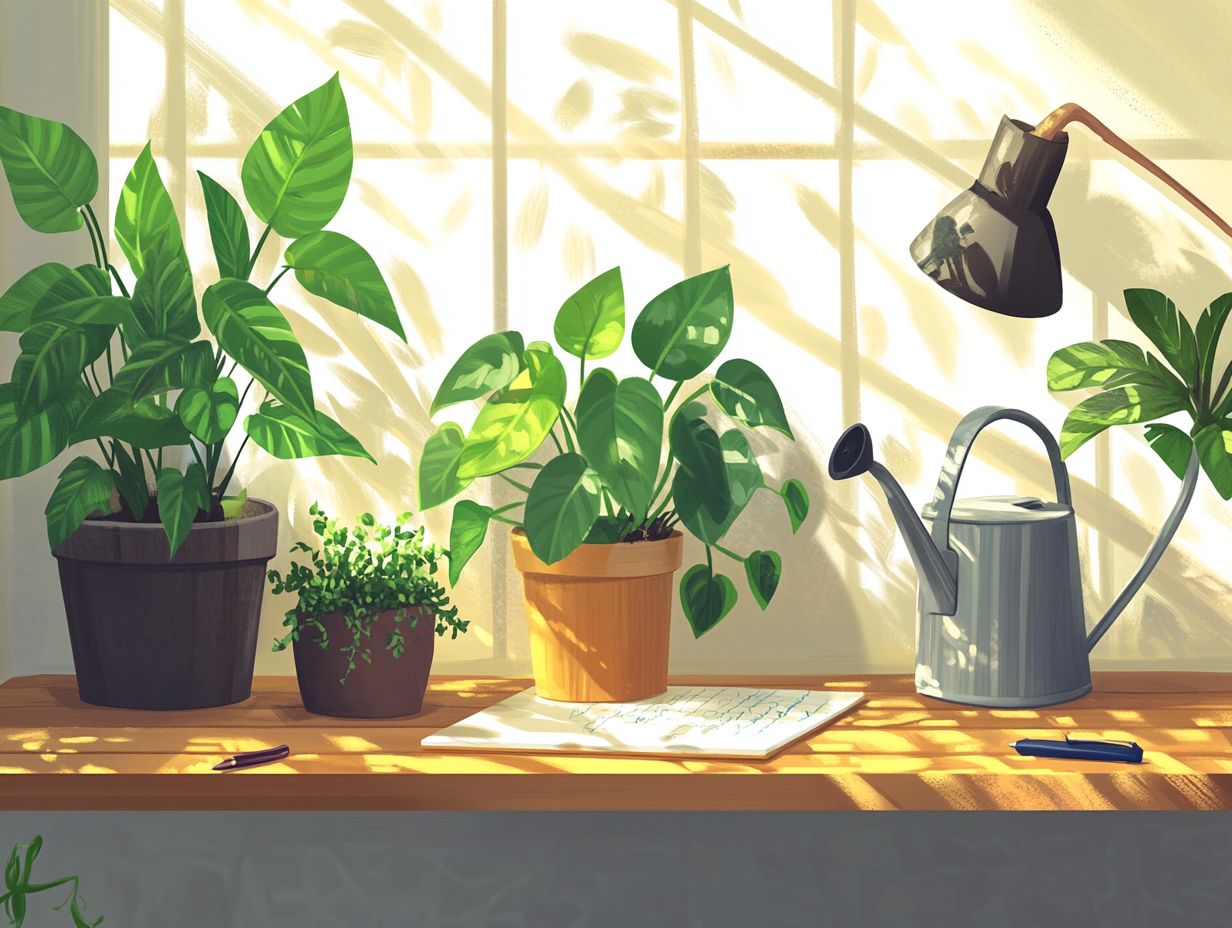
Providing adequate sunlight exposure is essential for the health of your houseplants. Insufficient light can result in yellowing leaves and distorted growth, while optimal lighting conditions encourage vibrant indoor gardening.
Each plant species has its own unique light requirements, varying from low to bright indirect sunlight. These needs play a crucial role in their vitality.
To assess the sunlight in your home and ensure optimal light conditions, take a moment to observe how natural light flows throughout the day. Notice which areas bask in direct rays and which remain shaded. This simple observation will guide you in finding the best spots for your plants.
If your plants aren’t getting enough natural light, try using grow lights specifically designed for various plant needs. These lights can effectively mimic sunlight, providing the necessary energy for photosynthesis and ensuring lush growth even in less-than-ideal lighting conditions.
5. Managing Humidity Levels
Managing humidity levels is vital for the well-being of your tropical plants and can significantly affect their overall health and vitality. Low humidity can lead to problems like leaf drop and declining plant health.
Use simple methods to increase humidity in your indoor garden. For instance, using tools like hygrometers, which measure moisture in the air, allows you to accurately gauge humidity levels.
Humidifiers are a popular choice for good reason; they efficiently disperse moisture throughout your space, creating an environment reminiscent of a lush tropical rainforest.
You can also place water trays filled with pebbles beneath your pots to facilitate evaporation and elevate humidity in localized areas. It s also crucial to understand the specific humidity needs of your plants.
For instance, ferns and orchids thrive in higher humidity, while succulents prefer drier conditions. By adopting these techniques, you can cultivate the perfect environment that encourages healthy growth and vibrant blooms in your indoor oasis.
6. Identifying and Treating Pests and Diseases
Identifying and treating pests and plant diseases is essential for maintaining the health of your indoor plants. Issues like sticky residue and tiny flying bugs often signal infestations that require your immediate attention, with solutions like neem oil or insecticidal soap at the ready.
Among the most common nuisances are spider mites, which leave behind fine webbing on leaves, and thrips, recognizable by their slender bodies and the dark streaks they create on foliage. Inspect your plants regularly catching problems early means less work later!
To prevent these issues, ensure adequate humidity, as both pests thrive in dry conditions. Regularly cleaning your plants will also help eliminate potential habitats for these unwanted guests.
If an outbreak occurs, a thorough wash with water can dislodge many pests, while targeted treatments like insecticidal soap effectively tackle the culprits. By staying vigilant and proactive, you can cultivate a thriving indoor garden free from unwanted invaders.
7. Pruning and Maintenance
Pruning and maintenance are essential for fostering healthy growth patterns in your indoor plants. This contributes to improved air circulation and overall plant health. Regular trimming enhances airflow and prevents weak growth.
By thoughtfully removing dead or overgrown leaves and branches, you can encourage new growth while shaping your plant to maintain its aesthetic appeal. Timing is crucial; for many species, late winter or early spring is the ideal time, allowing your plants to bounce back as they enter their active growing season.
The techniques you employ, such as pinching back tips or selectively shortening stems, will depend on the type of plant you care for. Each plant may have unique maintenance needs. For instance, tropical varieties often thrive with more frequent light pruning, while succulents appreciate a gentler approach.
Imagine a well-pruned plant that not only flourishes but dazzles with its vibrant, lush appearance! This captivating look enhances the beauty of your indoor gardening space.
How Often Should You Water Indoor Plants?
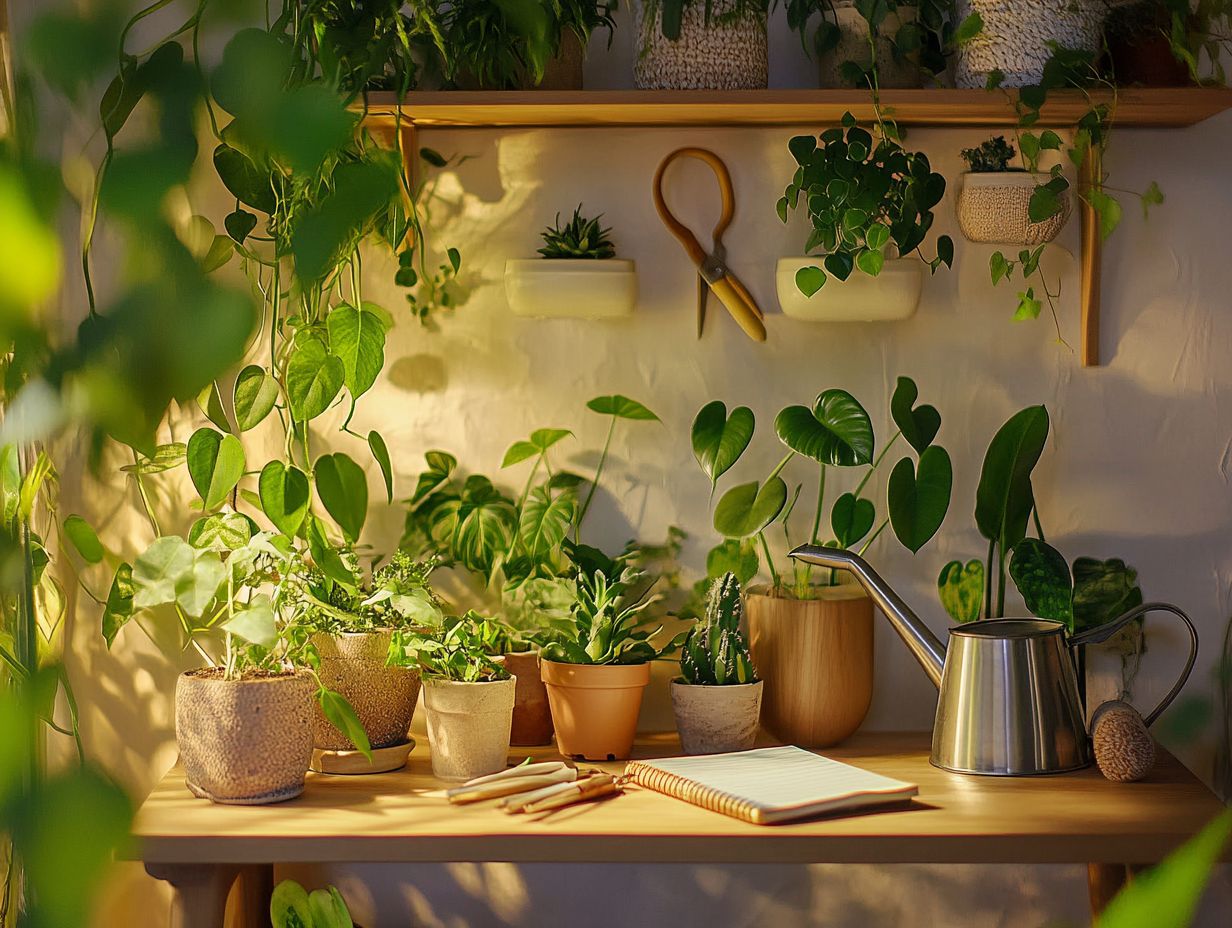
Understanding how often to water your indoor plants is essential for their well-being. Improper watering can lead to frustrating issues like yellowing leaves, dropping leaves, and dreaded root rot, common problems for houseplants.
Several factors are crucial in determining the right watering frequency. Each plant type has its own unique moisture needs. For example, succulents require significantly less water compared to tropical plants that thrive in humid environments. Soil moisture, or how wet the soil is, also plays a key role well-draining mixes dry out quickly, while clay soils can hold moisture for longer periods.
Environmental elements like temperature, humidity, and light exposure also influence evaporation and the moisture level in the soil. To make more informed watering decisions, consider using a moisture meter. This handy tool measures the soil’s moisture content, ensuring your plants receive the perfect hydration without guesswork.
Keep an eye on your plants and adjust your watering accordingly for a thriving indoor garden!
What Are the Most Common Mistakes in Indoor Plant Care?
Common mistakes in indoor plant care can lead to many issues for your beloved houseplants. Neglecting signs of distress, such as yellowing leaves, dropped leaves, or discolored leaves, can compromise their health.
Many indoor gardeners often underestimate the importance of a proper watering schedule. This can result in the all-too-common plight of overwatering. This misstep can cause problems like root rot, weak growth, and fungal diseases that disrupt your plant s health.
Inadequate lighting can stunt growth, leading to leggy plants and distorted growth. Ensuring that your indoor garden receives ample and appropriate light is crucial for thriving greenery.
Don’t neglect pest control it can quickly lead to infestations! Tiny flying bugs and spider mites can spread rapidly, endangering multiple plants in your space.
For dedicated indoor gardeners, regularly checking moisture levels, investing in quality grow lights, and keeping a vigilant eye on plant health can make all the difference in cultivating a flourishing indoor oasis. To enhance your gardening skills, refer to these best practices for indoor plant care.
What Are Some Signs of Overwatering and Underwatering?
Recognizing the signs of overwatering and underwatering is crucial for maintaining the health of your indoor plants. Symptoms like yellowing leaves and root rot can signal serious issues that threaten their vitality and beauty.
- Overwatered plants may present:
- Yellowing leaves
- Mushy stems
- Musty odor from the soil
- Wilting despite soggy conditions
- Underwatered plants typically showcase:
- Browning leaf tips
- Crisp leaves
- Soil that pulls away from the container
To discern between the two, check the soil moisture with your finger or a moisture meter. If it feels consistently wet, overwatering is likely the culprit; dryness points towards underwatering.
To remedy these issues, adjusting your watering schedule and ensuring proper drainage are essential steps that will allow your green companions to thrive once more.
How Can You Improve Air Circulation for Your Indoor Plants?
Improving air circulation for your indoor plants is essential to prevent issues like pests and fungal diseases. Stagnant air can lead to a range of health problems for your plants.
To enhance airflow, consider implementing a few practical strategies:
- Maintain proper spacing between your plants to allow for better air movement. This reduces the likelihood of moisture buildup.
- Incorporate fans to boost circulation significantly. A gentle breeze mimics natural conditions outdoors.
- Ensure adequate ventilation in your indoor garden. Open windows or use exhaust fans to invite in fresh air.
By combining these methods, like ensuring proper drainage and incorporating grow lights, you create a healthier environment for your indoor plants. This promotes their growth and safeguards them against unwanted pathogens. Additionally, knowing when to worry about your indoor plant can help you address any issues promptly.
What Are the Best Fertilizers for Indoor Plants?
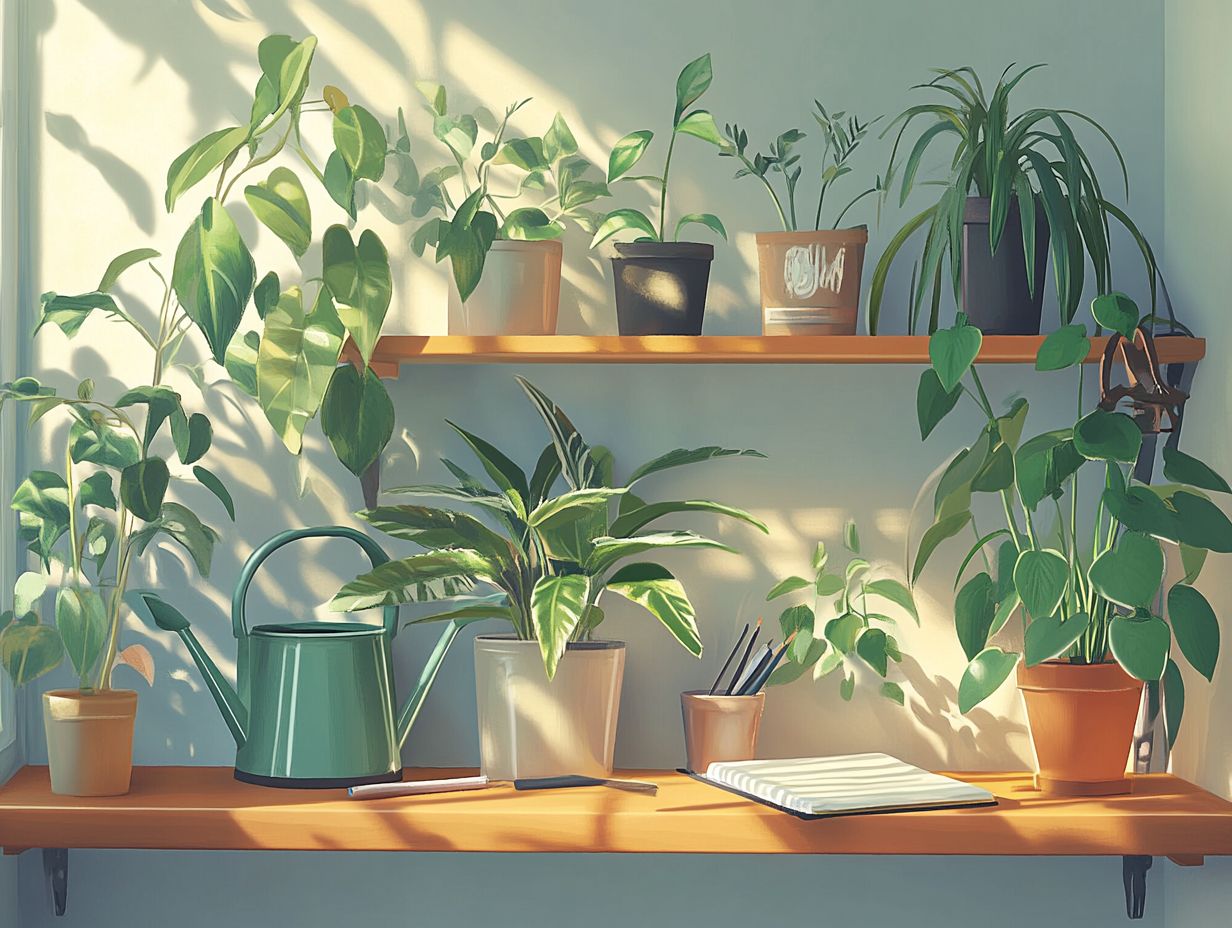
Choosing the right fertilizers for your indoor plants is essential to ensure they receive optimal nutrition and thrive. The proper nutrients can help you avoid common issues, such as weak growth and yellowing leaves.
You have various fertilization options available, from organic choices like compost and fish emulsion to synthetic alternatives like slow-release formulations, which gradually provide nutrients. These options deliver essential big nutrients like nitrogen, phosphorus, and potassium, along with small nutrients crucial for maintaining overall plant health.
When applying fertilizers, follow the manufacturer’s instructions and consider each plant’s unique needs and growth patterns. Timing is also vital; fertilizing during the active growth phases of spring and summer yields better results. Scale back or stop applications in autumn to allow your plants to rest and rejuvenate.
How Can You Create a Suitable Environment for Your Indoor Plants?
Creating the perfect environment for your indoor plants is about striking the right balance between light, humidity, and temperature stability. This promotes optimal growth and resilience, ensuring your plants are well-nurtured.
Each houseplant has its own set of requirements. Tailor these elements to suit their specific needs. For example, tropical plants flourish in high humidity a condition you can achieve easily by using humidity trays filled with water and pebbles. This setup maintains moisture in the air around them, creating a mini rainforest vibe.
Incorporating grow lights can elevate your plants’ growth, especially in cozy, low-light spaces where natural sunlight isn’t enough. Opt for full-spectrum lights to closely mimic sunlight, adjusting the distance and duration based on how your plants respond.
With a little attention, you can easily transform your space into a thriving oasis for your plants!
Start implementing these tips today for a lush indoor garden!
What Are Some Common Indoor Plant Pests and How Can You Get Rid of Them?
Common indoor plant pests, such as spider mites and thrips, can wreak havoc on your beloved greenery. They often leave behind a sticky residue and cause distress that requires effective pest control measures.
Identifying these pests early is essential. You ll notice spider mites weaving fine webs between leaves, while thrips reveal themselves as tiny, slender insects that can discolor your foliage. Other culprits to watch for include:
- Aphids, which tend to cluster on new growth,
- Mealybugs, easily recognized by their cotton-like appearance.
To safeguard your indoor garden, make it a habit to conduct regular inspections and maintain the right humidity levels to deter infestations. When pests do make an appearance, consider using natural remedies, such as neem oil, which comes from the neem tree and is safe for plants. Insecticidal soap is a special soap that suffocates pests.
By combining these strategies, including regular plant inspections, you ll not only address current issues but also help prevent future outbreaks, ensuring your plants thrive beautifully.
What Are the Benefits of Having Indoor Plants?
Having indoor plants brings a wealth of benefits, including improved air circulation and enhanced plant health. These benefits contribute to a more vibrant living environment and help prevent plant diseases.
Indoor plants do more than just look good they improve air quality by removing toxins and increasing oxygen levels, creating a healthier environment. The presence of indoor plants can also elevate your mental health by reducing stress and fostering feelings of calm. Engaging with nature whether it s through watering, pruning, or simply admiring their beauty can significantly lower anxiety levels.
With the right care, such as keeping an eye on light conditions, humidity, and temperature, these plants will thrive, amplifying their positive effects on both your environment and overall well-being.
Frequently Asked Questions
What are the top 7 tips for indoor plant care troubleshooting?
1. Check for proper watering: Overwatering and underwatering are common causes of plant problems. Make sure to water your plants according to their specific needs and ensure proper drainage.
2. Monitor lighting: Too much or too little light can cause issues for indoor plants. Check the lighting in your home and adjust accordingly, considering the light conditions for your specific plants.
3. Consider humidity levels: Indoor plants thrive in humid environments, so if your home is dry, consider using a humidifier or misting your plants regularly to maintain optimum humidity levels.
4. Check for pests: Insects and other pests can wreak havoc on indoor plants, such as spider mites and tiny flying bugs. Keep an eye out for any signs of infestation and treat accordingly.
5. Prune regularly: Trimming dead or damaged leaves and stems can help prevent further issues, encourage plant resilience, and promote healthy growth.
6. Use appropriate soil: Different plants require different types of soil, such as potting soil or potting mix. Make sure your indoor plants are planted in the right type of soil for their needs.
7. Know your plant’s needs: Each plant has its own unique care requirements, including plant maintenance tips. Make sure to research and understand the specific needs of your indoor plants to ensure their health and growth.

